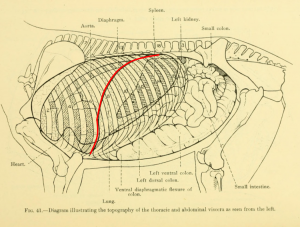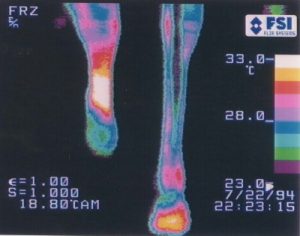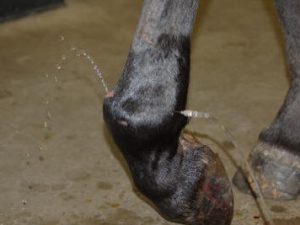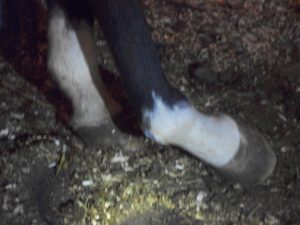Large animal wounds
Evaluation for critical structure damage
Some wounds require emergency care, either on farm or at a referral center or both. Identification of these factors early on can dramatically improve prognosis.
Triage plan for emergency care
ABC assessment – Airway, breathing, circulation+
- Any involvement of the chest cavity, airway or vessels?
- Any involvement of the abdominal cavity?
- Significant blood loss?
- Loss of blood supply to the limb?
- Significant lameness?
Any risk of joint or tendon sheath involvement?
- Wounds near tendon sheaths or the “bendy bits” of the limb?
Any risk of flexor tendon involvement?
- Does the wound affect the palmar/plantar surface of the lower limb?
Any risk of long bone fractures?
- Is there any abnormal angulation or instability of the limb?
Body cavity trauma
Wounds over the thorax or abdomen can penetrate either the abdominal cavity, the thoracic cavity or both. Due to the shape of the diaphragm, any wound after the 6th intercostal (between rib) space can enter the abdominal cavity.

If the thoracic cavity is penetrated, the horse may develop life threatening pneumothorax.
Body cavity damage should be suspected in any wound over the torso that goes deeper than 1-2 cms, particularly if the patient is showing abnormal respiratory movements, nostril flaring, elevated heart rate or change in mucous membrane color.
Vascular damage
Most wounds do not lead to significant blood loss. However, if an artery is cut, blood loss can be fatal. In distal limb wounds, the palmar/plantar digital artery can be damaged. Arterial damage leads to pulsatile and audible spurts of blood. These cases need on farm management to stop blood loss followed by in hospital care. Remember, the blood supply to the lower limb is reliant on those arteries; there is minimal collateral circulation.
Some injuries will transect or crush vessels, leading to vascular compromise. Distal limb temperature and sensation should be evaluated prior to further treatment. Blood supply is required for healing and cannot currently be surgically replaced in large animals. If blood supply is compromised and the limb is cold, larger animals should be euthanized. Goats can tolerate limb amputation.

Significant lameness
Significant (lame at a walk or non-weightbearing ) lameness is unusual with wounds. Evaluation for deeper or more extensive damage is indicated. Check for fractures and tendon/ligament injury.
Synovial damage
Limbs of large animal species have minimal protective muscle or fat. It is relatively easy for wounds to penetrate joints and tendon sheaths or to damage nerves and tendons. Knowledge of limb anatomy is crucial. Any wound over a joint or in the region of a tendon sheath should be evaluated for penetration of synovial structures. Remember the joint capsules extend proximally and distally beyond the bones of the joint and that the deep flexor tendon sheath runs on the palmar/plantar surfaces of the lower third of each cannon bone and down through the pastern region.
bone and down through the pastern region.
One of the easiest ways to evaluate synovial penetration is to attempt to distend the joint or tendon sheath. These structures should pressurize with added fluid. If the structure is intact, it should get harder and harder to add more fluid. When pressurized, you should have fluid shooting out of the needle or forcing the syringe plunger outwards. If the structure cannot be pressurized, it is leaking through the wound. To pressurize the structure, the needle should be inserted through a cleaned area with intact skin and not over the wound or disturbed tissues (or you will create more issues due to infection).
Flexor tendon injury
The flexor tendons run on the palmar/plantar aspects of the limbs and are responsible for limb support. If the superficial tendon is damaged, the animal may have a slightly dropped fetlock. If the deep flexor tendon is disrupted, the toe will be elevated when the horse walks. Damage to the suspensory ligament (breakdown injury) is associated with a markedly dropped fetlock and often includes damage to the vascular supply from overstretching. If flexor tendons are partially damaged, further weight bearing can lead to complete tears. It is important to stabilize these injuries as soon as possible to minimize further damage.
Rupture of the deep digital flexor tendon:
Limb instability
Wounds leading to long bone fractures, joint dislocations, collateral ligament damage, nerve damage, and/or flexor tendon transection will lead to limb instability. Horses that cannot bear weight on a limb or that have limb angulation should be sedated, splinted and referred. See Emergency Orthopedics

Key Takeaways
Referral is indicated and prognosis potentially drops if any of the following are possible:
- synovial or body cavity involvement
- limb instability
- major vascular damage
Resources
See the following sections for management.
Wound Management: Wounds with Special Challenges, VCNA Vol.34(3), pp.511-538, 2018
Ibooks- Landmarks of the thoracic limb; UGA 2016; Bones and joints of the thoracic limb, UGA ; Bones and joints of the pelvic limb, UGA 2020

